Britain Hasn’t Had a Rocket in Half a Century. Now the Black Arrow is Back.
The country’s only shot at a nuclear missile is inspiring a new shot at a future in space.
/https://tf-cmsv2-smithsonianmag-media.s3.amazonaws.com/filer/78/cf/78cf247a-6f8f-47d9-bae1-9145db5e45d6/09e_sep2019_skyrorablackarrowexhibit_live.jpg)
Somewhere between 300 and 800 miles above sea level, depending on the time of day, a quietly bitter joke has been orbiting Earth for almost 50 years. The satellite Prospero, launched in 1971—carrying an instrument to detect micrometeorites in low-Earth orbit—is small, about a yard and a half across, and rather flattened, with, according to the satellite-tracking website N2YO, “an external shape similar to a pumpkin.”
It was the first satellite launched by a British rocket, the remarkable Black Arrow. It was also the last. Prior to its launch, literally as the rocket was en route to the launch site in Australia, the British space program was canceled and funding withdrawn. Britain became the first, and so far the only, nation to develop a satellite launch capability and then abandon it.
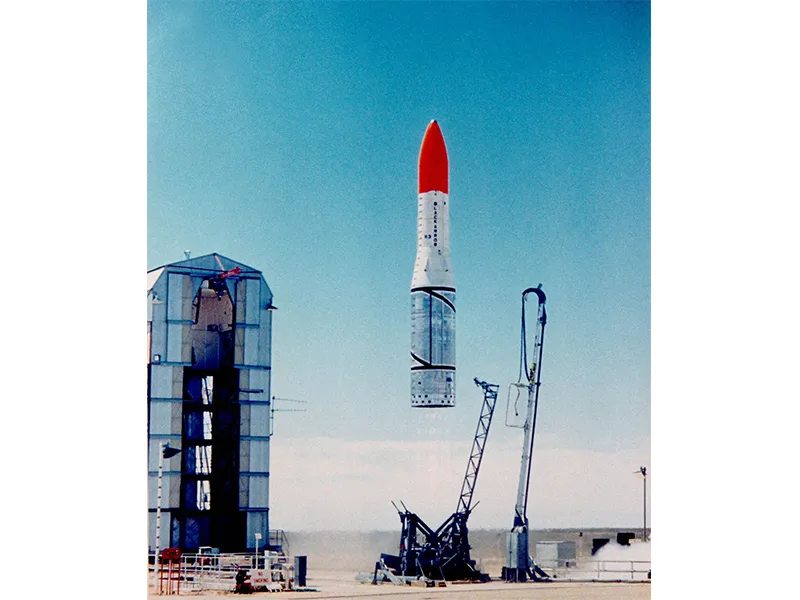
Originally, the plan had been to call the satellite “Puck,” after the character in A Midsummer Night’s Dream, who “girdled the Earth.” But, according to a possibly apocryphal story, that name was deemed too upbeat, too hubristic, given the coming end. (It is also rumored that the risk of mispronunciation by angry engineers was considered too great.) Its creators changed its name to Prospero. That’s the joke: the sorcerer Prospero, at the end of The Tempest, voluntarily gives up his powers.
Prospero is still hurtling through space, in a polar orbit, looping once round the Earth every 103 minutes; it is expected to remain there until around the centenary of its launch. But Black Arrow, its launcher, is finished. The first stage crashed into the Australian outback, 150 miles or so from its launch site at the Woomera rocket range in South Australia. And there it lay for nearly half a century, gathering dust and graffiti, until the turn of this year—when a new Edinburgh-based space company, Skyrora, paid for its return to Britain, albeit the other end of Britain from where it started. The company hopes in the next couple of years to build a rocket of its own—very similar in its core propulsion system to the innovative Black Arrow—which will launch satellites under a British flag. This time, the rocket will spring from Britain’s own shores, not from a distant part of the Commonwealth.
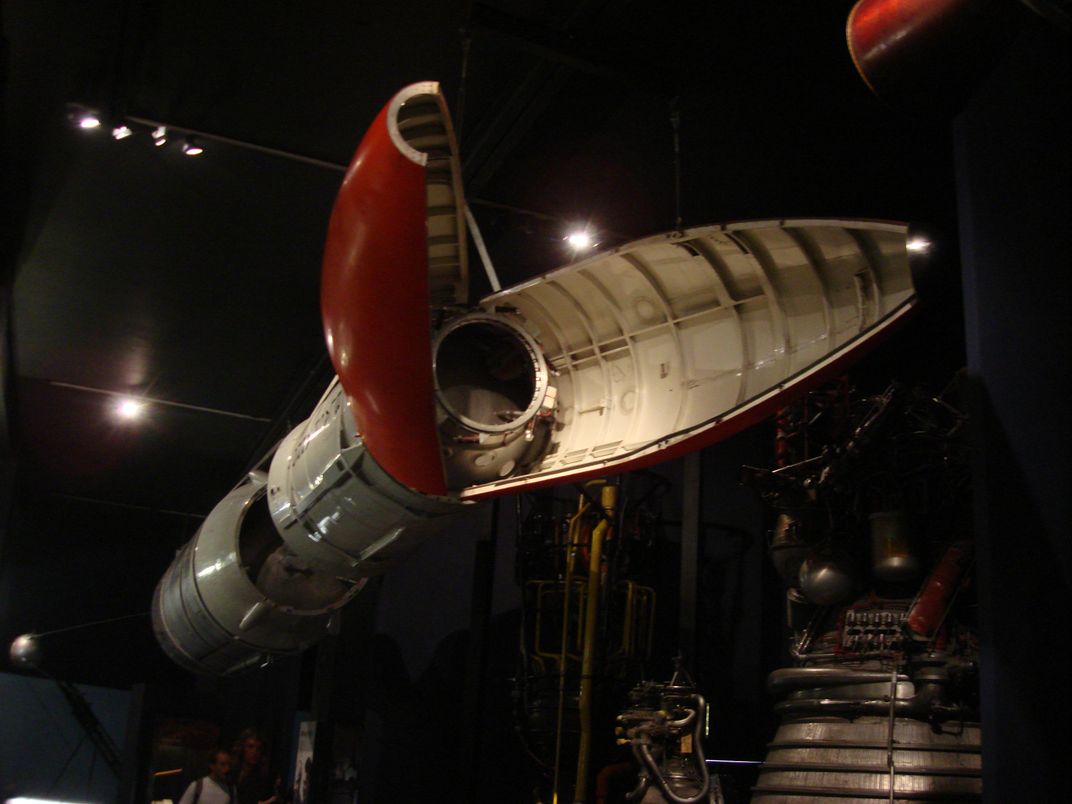
The plan is to launch smallsats into polar orbit. One reason the Black Arrow failed is that there was no market for the payload it could lift: A small satellite, at the time, could do very little. Now, though, the miniaturization of technology means that it is feasible to launch powerful tools into space in relatively small packages—and Britain manufactures 44 percent of the world’s small satellites.
The remains of Black Arrow now sit on a pair of wooden pallets by the wall of a warehouse in Penicuik, a small town a few miles outside Edinburgh. It’s a large object, on a human scale—on its side, it stands six and a half feet tall, and about 18 feet long—although, by the standards of the sort of rocket launched from Cape Canaveral, it’s a midget. “Black Arrow would almost fit sideways across the bottom of Saturn V,” says Robin Hague, Skyrora’s lead engineer.
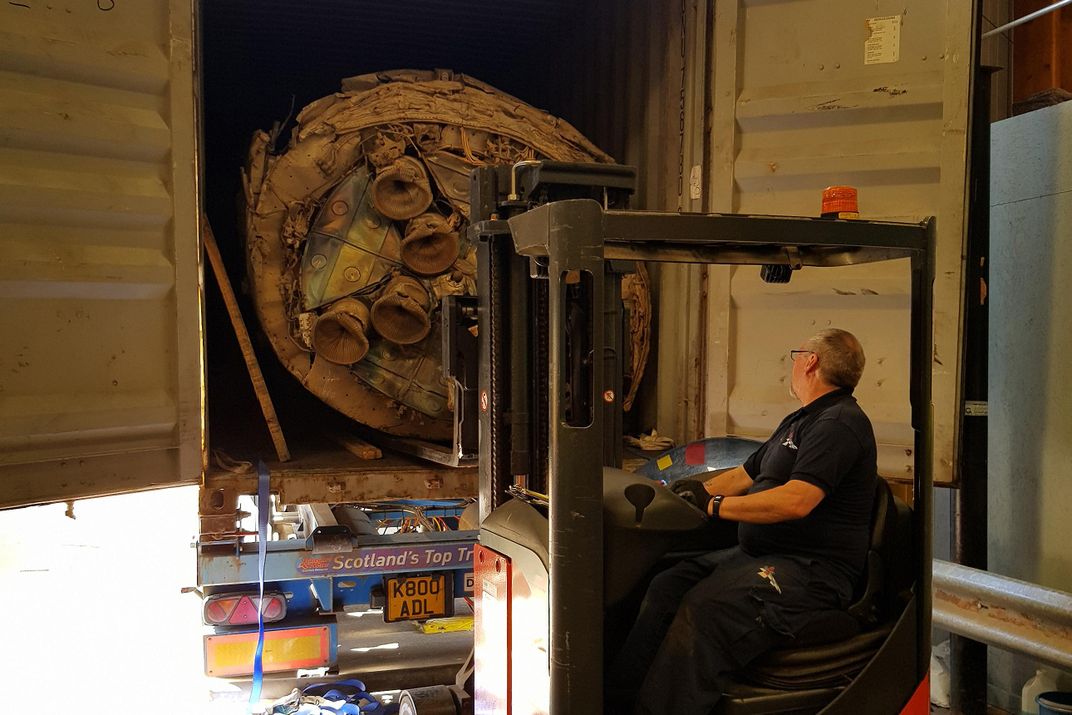
When I see it, it’s dented and scratched but still very recognizably a rocket. The eight rocket nozzles are still in place, albeit squashed by the impact of landing. The body consists of two tanks, one atop the other. The lower, larger tank contained hydrogen peroxide, and the smaller one kerosene. Hague and his colleague Derek Harris, the company’s business operations manager and the man behind bringing Black Arrow home, are clearly fond of the old rocket. They pat it affectionately from time to time, as though it were an elderly family pet, and they are keen to point out how ingeniously low-tech it is. For instance, the eight rocket nozzles are arranged in pairs, and linked to an old-fashioned mechanical gyroscope, like an airplane’s artificial horizon. If the rocket strayed from vertical, the movement of the gyroscope moved a pair of nozzles to push it upright again. There was nothing digital in the entire mechanism.
The story of Black Arrow goes back to 1955, according to Doug Millard, a space historian and curator of the aerospace displays at London’s Science Museum, when Britain began a program to develop its own ballistic missile capabilities.
Britain, like the United States, had gotten hold of German rocket scientists after the war. The key one was Hellmuth Walter, who had been working on a different kind of rocket than the V-2, which used liquid oxygen to burn its fuel. Instead, Walter’s engines used highly unstable hydrogen peroxide. The most high-profile use had been in a tiny rocket-propelled interceptor, the Messerschmitt Me 163 Komet, a strange-looking paper dart of an aircraft, which set a world speed record of 1,004.5 kilometers an hour (623.8 mph). However, it didn’t prove itself to be an effective weapon, due in part to its tendency to explode.
Hydrogen peroxide is unstable, but it has many advantages. One is that its very instability makes it an excellent source of oxygen: It just needs catalyzing. “If you force peroxide through a stack of silver-coated mesh,” says Hague, “which is what is done in these engines, it falls apart spontaneously into superheated steam and oxygen.” The volume of steam itself provides significant thrust—the Bell Rocket Belt, as worn by Sean Connery in the James Bond film Thunderball, was powered solely by peroxide catalysis.
In the Walter engines, that steam and oxygen are combined with kerosene, which ignites instantly in the heat. “All you need to do to light your engines is open the valves,” says Hague, so it’s easy to switch your engines on and off in space for maneuvering. It also has the advantage that peroxide can be stored at ambient temperatures, unlike liquid oxygen, which needs to be kept below its boiling point of minus 183 degrees Centigrade (minus 297.3 degrees Fahrenheit).
“If you want to build a rocket which would launch a megaton rocket to Moscow,” says Nicholas Hill, author of A Vertical Empire: The History of the UK Rocket and Space Programme, 1950-1971, “the warhead is going to fly out of the atmosphere and come back in at a speed of about 4 km/s (9,000 mph).” British researchers had to tackle the problem of designing a warhead shape that would allow for stable re-entry while protecting the payload from the heat generated by atmospheric friction.
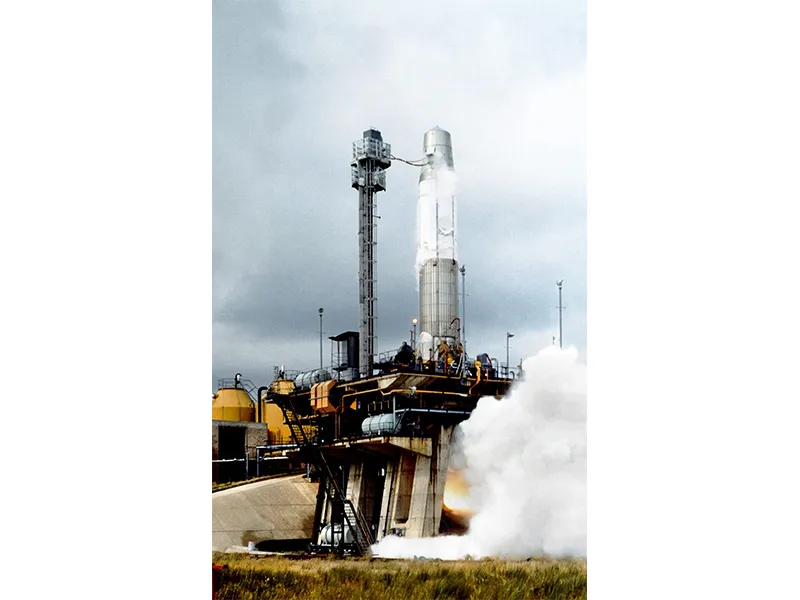
To that end, the British government commissioned work on the Blue Streak medium-range ballistic missile and the Black Knight, a launcher dedicated to developing and testing a re-entry vehicle by hurling a payload 600 miles up and “seeing what happened when it came down again. And it launched in Woomera and was pretty successful,” says Hill.
Work on Black Knight began at the Saunders-Roe aircraft factory on the Isle of Wight off England’s south coast. Terry Brook was an apprentice fitter there, helping with the assembly of the peroxide tanks. After the Black Knight’s successful launch, the government decided to go a step further and build a new rocket that could put small satellites into a low-Earth orbit. His apprenticeship over, Brook was invited to join the Black Arrow project. It was a low-budget enterprise, he says—nothing like the flashy U.S. space program.
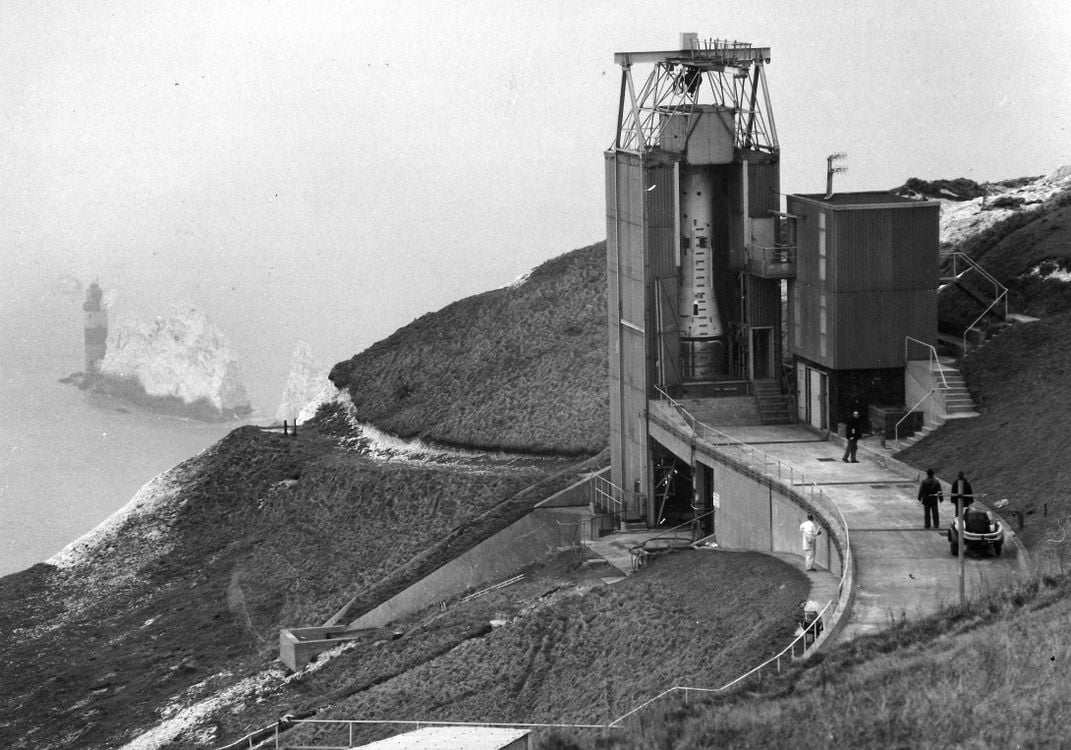
But the precision required was extraordinary, Brook recalls. The seam-welding had to be perfect. If there were any gaps, it would leak. If there were any overlaps, it would split. Brook remembers testing the kerosene and peroxide tanks at the Isle of Wight site, pressurizing them for two hours. Everything was down to “a tenth of a thousandth of an inch,” he says, and “there had to be no leaks. Lo and behold there weren’t.” Some American rocket engineers came to visit the Saunders-Roe factory and looked at the job, he says. “They said there’s no way you can build it....You just won’t be able to do it.” He has a gleeful pride in his voice as he says this, because he knows that, in fact, they did.
“We didn’t have clean areas or anything. I remember one time we bolted the second-stage motor onto the rocket, and we didn’t have much time, so we did it in the dinner hall. All I wore was my navy overalls.”
At the same time, Marlene Irving, another Isle of Wight resident, worked in data reduction on the static firings. “We’d go through the results of how the engine performed and see whether it was fit to go,” she says. Like Brook, she remembers it as a shoestring operation—and one that has been largely forgotten. “The rocket fuel used to come over on the car ferry; health and safety eat your heart out. There’s a museum of sorts, but I meet people who’ve lived their whole life on the island, and they don’t know anything about it.”
Brook worked on all of the Black Arrow rockets—from the first, R0, to the fifth, R4, although he left before R4 was completed. R2, which was launched in September 1970, was the first to carry a satellite, called Orba. But the rocket’s second stage engine switched off too early, and the satellite did not reach orbit. R3, in October 1971, successfully carried Prospero into its century-long vigil around Earth. It is R3’s first stage that lay in the Australian dust for so long.
After R3, Britain folded up its launch program. It would have required many tens of millions of pounds more funding to continue the program—money that an increasingly cash-strapped Britain was keen to spend elsewhere. American Scout rockets offered a more cost-effective alternative for launching satellites.
And so, R4 was never launched; it lives on in London’s Science Museum. Brook’s colleagues were shunted into other roles, or dismissed; he had been given a promotion just as the closure was announced, and with a heavy heart left the program.
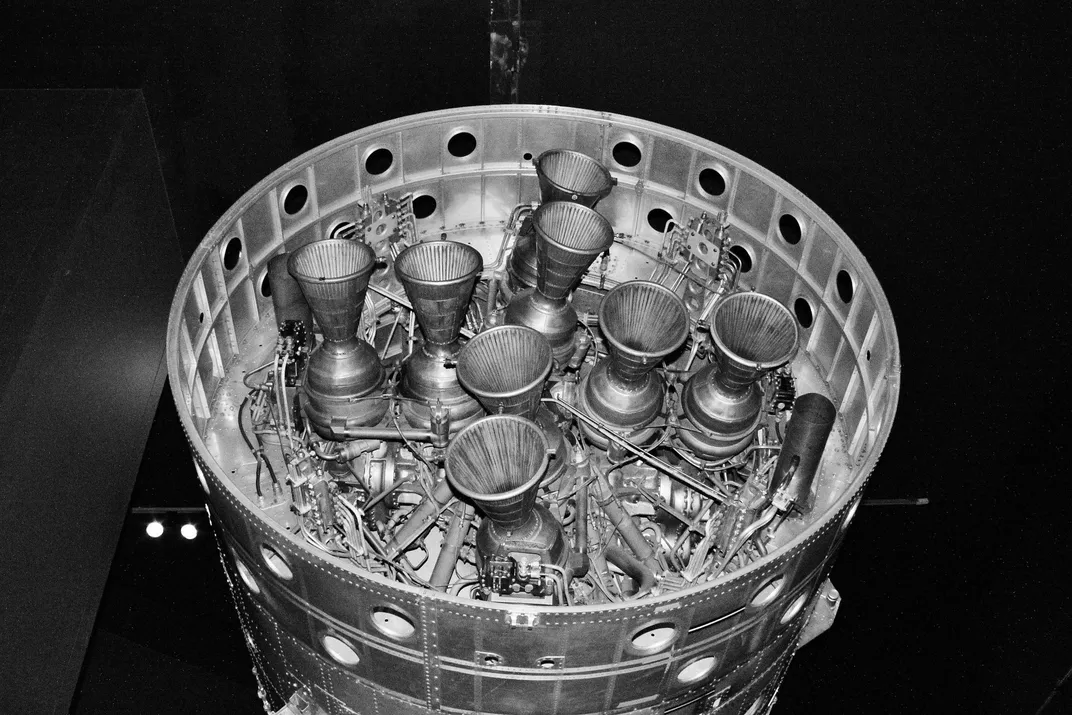
But Britain’s space industry never quite went away. “The U.K. left rockets behind,” says Millard, “and focused on satellites, which is a very successful industry.” Portsmouth and Stevenage, in particular, became hubs for satellite manufacturing—their portfolio includes the NovaSAR radar satellite for monitoring the environment and the LISA Pathfinder orbiting observatory for studying gravitational waves. Universities have developed innovative new designs: Sir Martin Sweeting at the University of Surrey in Guildford led the world in the development of small satellites, years before Cal Poly and Stanford University developed the specifications for CubeSats (a maximum of 2.9 lbs). In 1979, Sweeting began building UoSAT-1, the first modern “microsatellite,” weighing about 154 lbs, and persuaded NASA to piggyback it on a Delta rocket. Then in 1985 he set up a company called Surrey Satellite Technology Ltd, which built one of the first “nano” satellites at 7.7 lbs in 1998.
In 2009, then-science minister Paul Drayson, a member of the House of Lords, announced the creation of a U.K. Space Agency. The country was recovering from the financial crisis, and the space industry—which had continued to grow despite the crash—looked like a good government investment: “high-value, small-volume, sophisticated manufacturing,” as Hague puts it. British firms account for about six percent of the world’s space industry, partly because telecom firms like Sky buy a lot of satellites. The government’s goal is to push that share to 10 percent by 2030.
“The U.K. is well placed to play a role,” says Graham Turnock, current CEO of the U.K. Space Agency, pointing to the “very strong indigenous space sector” of manufacturing and research. What it lacks, though, is a way to put satellites in orbit. If it were to develop that capability, then the entire space ecosystem—everything from design to manufacture to launch—could take place in the British Isles.
Turnock says the far north of Scotland is ideal real estate for a space program. It’s near the ocean—where there would be no overflight of towns and cities—and at a latitude that makes it well suited for launching surveillance satellites into a north-south, “polar” orbit. As Earth rotates underneath it, the satellite is able to photograph the entire planet. Also useful is a near polar orbit, known as a “sun-synchronous” orbit, which keeps the satellite at the same point in the sky relative to the sun, allowing it similarly to take photos of the whole planet but in consistent light conditions. A launch site will be chosen from among three locations: Sutherland, the Shetlands, or the Outer Hebrides. Some funding has already been committed to the Sutherland site.
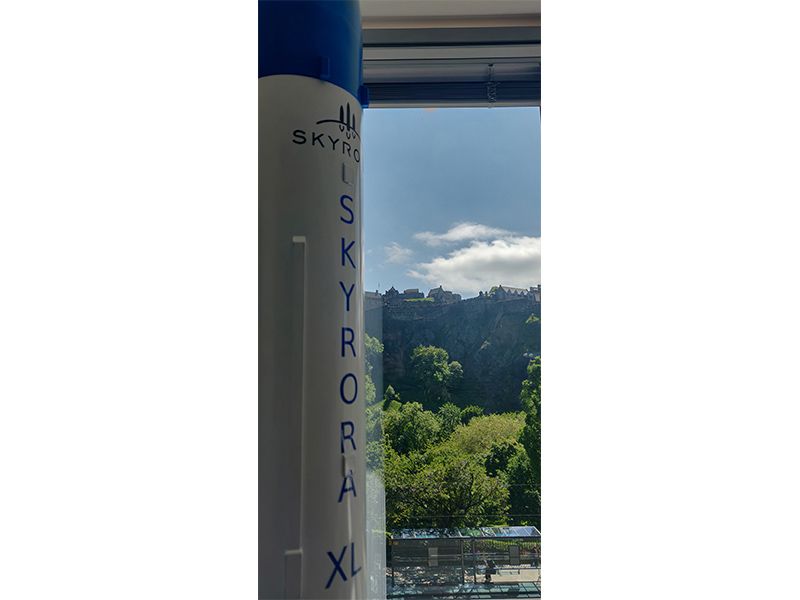
Skyrora’s business plan is to focus entirely on small satellites, unlike other rockets, such as the European Ariane or the SpaceX Falcon, which typically carry smallsats as part of a bigger payload. That means your satellite gets put into an equatorial orbit where the bigsat wants to go rather than the polar one you want, so your satellite needs its own propulsion, adding weight and expense. “A comparison I heard is that SpaceX and Ariane are like a bus,” says Hague. “They move a lot of mass but you have to go where the bus is going. We’re aiming to be the taxi. It’ll cost a bit more per kilo, but you go where you want.”
Skyrora, though, is entering a crowded field. An annual survey of the small-launcher market by Carlos Niederstrasser of Northrop Grumman finds that 101 of such vehicles are being designed worldwide, with at least 34 in active development.
But Harris says that, with thousands of small satellites waiting to be launched, even if Skyrora and some of their competitors do a dozen launches per year, “it won’t make a dent in the market.” Partly that’s because the satellites they plan to launch have a very limited life of five or, at most, 10 years, and will need to be regularly replaced, so the market will be constantly refreshed. Also, he says, “The U.S. thinks the market is overcrowded, but in real life out of all the different launchers being developed, a lot of them are presentation stage.”
Skyrora launched its first rocket in August 2018, a slender, almost eight-foot-long, dart-shaped vehicle that reached a height of nearly four miles. That was a simple solid-fuel engine, available commercially, little more than a steel tube lined with rubber-like propellant. But the company hopes to launch a nearly 11-foot rocket later this year, followed by an almost 20-foot-tall, two-stage hydrogen peroxide hybrid rocket. Skyrora’s ultimate aim is to build something that can carry a 315-kilogram (694-pound) payload to a 500-kilometer, sun-synchronous orbit.
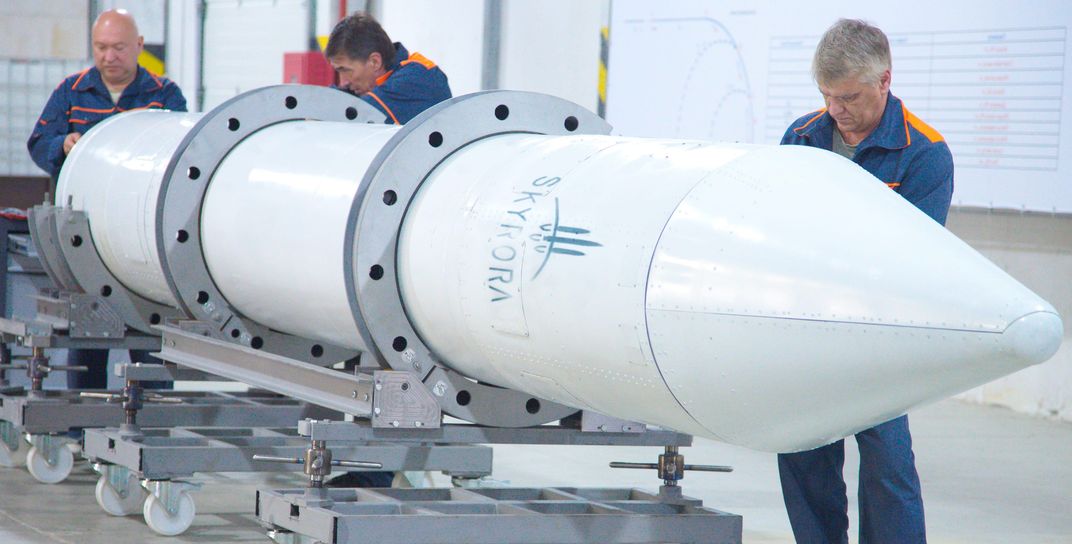
And, Hague points out, they’ll use the same peroxide-and-kerosene system that Black Arrow did. “We’re slightly fuel richer,” he says. “Black Arrow was about eight parts peroxide to one-part kerosene; we’re about six to one.” Black Arrow, because of its peroxide-heavy mix, took off on an almost invisible plume—none of the clouds of smoke and roaring flame of most rockets, making it look almost as though it hovered, eerily, on empty air. Skyrora’s rockets will not burn quite so cleanly.
But the peroxide system still has advantages. Although it’s not quite as efficient an oxidizer as liquid oxygen, it can remain in the rocket. Liquid oxygen needs to be kept at supercooled temperatures, and so rockets need to be filled shortly before the launch. “In Scotland’s lovely weather,” grins Harris, “it can change pretty quickly.” Usually, the weather will improve in a couple of hours, but, even if delays are longer, the rocket “can literally stay on the launchpad for days,” says Harris.
The similarity between Skyrora and Black Arrow—and, of course, the obvious public relations benefit—drove Harris to lead the effort to bring R3’s first stage home. William Creek, the town nearest where it lay, had no use for it, and local youth were defacing it (“Putin did it better” can be seen carved into one panel). Skyrora paid them a four-figure sum, collected it in a land train, and had it carried by container ship to Felixstowe in Suffolk. Now it’s going to do some tours of airshows and museums.
Brook, the former fitter, is thrilled. “We were the forgotten ones,” he says. Black Arrow, and especially the men who assembled it in that Isle of Wight workshop, had been neglected, he felt, and a great chunk of British expertise had been lost. Almost all of Brook’s old colleagues are dead—he is 78 and had been among the youngest on his team.
As Prospero continues its lonely orbit and Black Arrow runs a victory lap around its birthplace, Britain moves closer to a spaceport. If it becomes a reality, the bitter joke will be laid to rest, as the sorcerer will have taken up his magic powers once again.
